Sapphire Radeon R9 290 Tri-X OC Review: Our First Custom Cooled 290
by Ryan Smith on December 24, 2013 3:45 PM EST- Posted in
- GPUs
- AMD
- Radeon
- Sapphire
- Radeon 200
Overclocking
Our final evaluation criteria is overclocking. Since the 290 Tri-X OC is based on AMD’s reference board, the card has the same overclocking functionality and capabilities as any reference card. Which is to say that we have voltage control and monitoring, but the board itself is not particularly engineered for extreme overclocking. At the same time the nature of putting together a card like the 290 Tri-X OC means that Sapphire is doing some degree of binning,
| Radeon R9 290 Overclocking | ||||
| Sapphire Radeon R9 290 Tri-X OC | Ref. Radeon R9 290 | |||
| Shipping Core Clock | 699MHz | 662MHz | ||
| Shipping Boost Clock | 1000MHz | 947MHz | ||
| Shipping Memory Clock | 5.2GHz | 5GHz | ||
| Shipping Boost Voltage | ~1.18v | ~1.18v | ||
| Overclock Core Clock | 824MHz | 790MHz | ||
| Overclock Boost Clock | 1125MHz | 1075MHz | ||
| Overclock Memory Clock | 6GHz | 5.6GHz | ||
| Overclock Max Boost Voltage | ~1.23v | ~1.18v | ||
For overclocking the 290 Tri-X OC, we increased the PowerTune limit by 20% and the voltage by 50mV to what’s roughly 1.23v. Out of this we were able to get another 125MHz (13%) out of the GPU and 800MHz (15%) out of the VRAM, now topping out at 1125MHz for the GPU boost clock, and 6GHz for the VRAM. The final clockspeeds are better than our previous efforts at overclocking our reference 290 (which was prior to voltage control), although only moderately so.
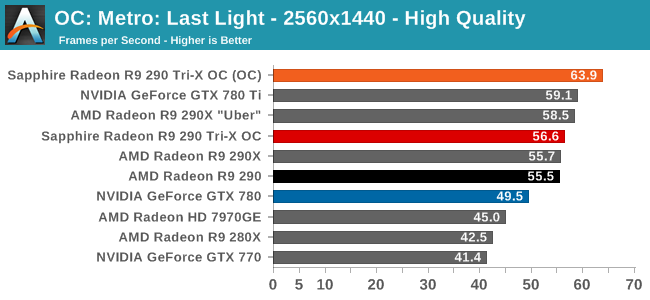
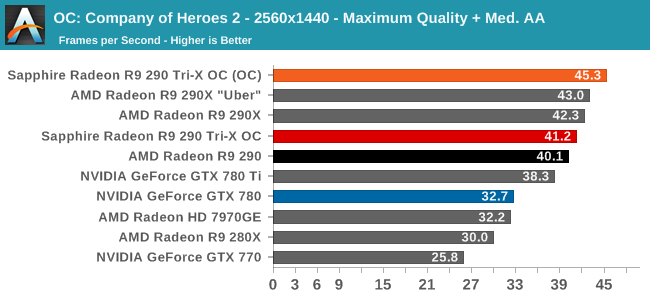
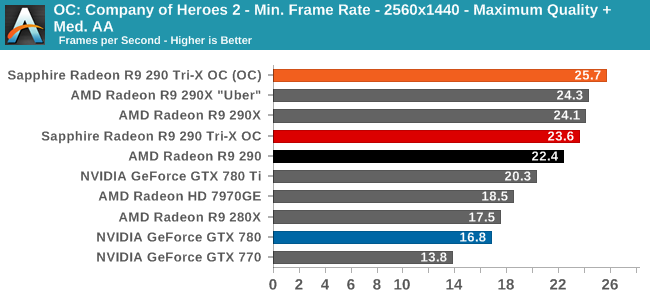
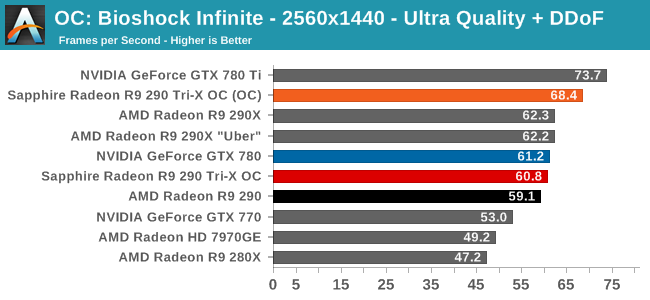
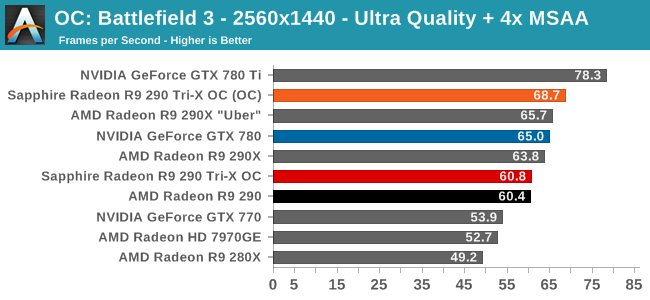
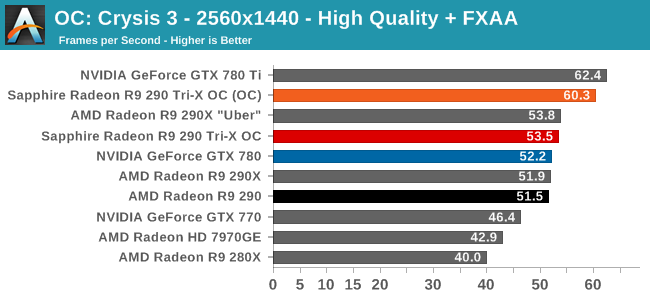
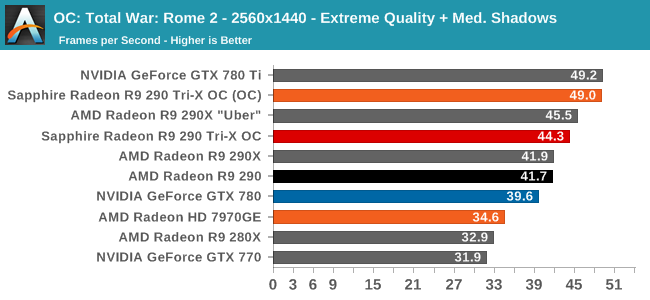
Starting first with gaming performance, as a more extensive overclock relative to Sapphire’s factory overclock, the performance gains from our own overclocking have yielded very solid results, despite the fact that this isn’t explicitly an overclocking board. Between the 13% core overclock and 15% memory overclock, the average performance increase measures in at 12%, varying depending on whether a game is more bandwidth limited, GPU limited, or CPU limited.
At 12% faster the overclocked 290 Tri-X OC is fast enough to largely close the gap between it and the reference GeForce GTX 780 Ti. Otherwise it will consistently outscore the 290X in “uber” mode, even in spite of the pared down nature of the Hawaii GPUs used in 290 cards.
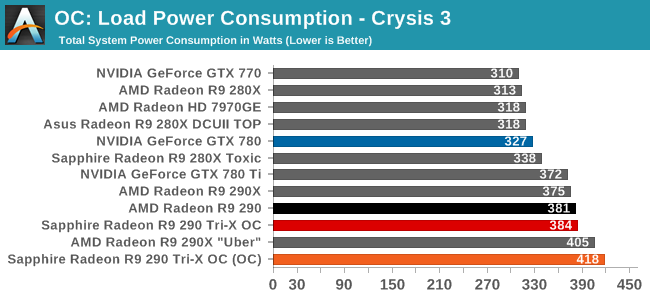
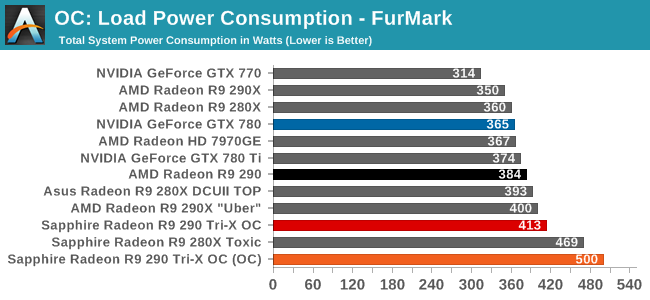
The power consumption penalty for overclocking is significant, but outside of the outright power limited FurMark, is not unreasonable. Under Crysis 3 the additional 13% in performance comes at a cost of 30W at the wall, most of which will be from the video card.
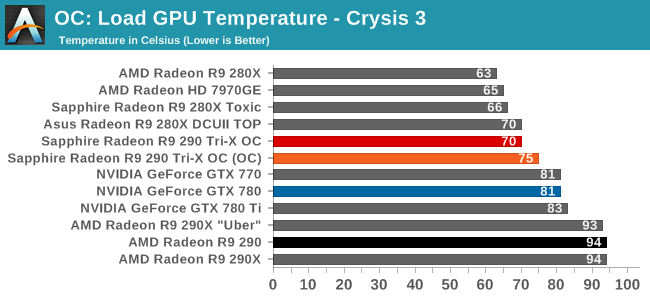

Along with power consumption overclocking also comes with the expected increase in operating temperatures. Under Crysis 3 this is an increase of 5C to 75C, while for FurMark (where the increase in power was greater) this is an additional 7C to 81C. FurMark definitely gives the Tri-X cooler a harder time when the video card is overclocked, but as this is a worst case scenario it also means that operating temperatures should still remain well under 80C, as evidenced by Crysis 3.

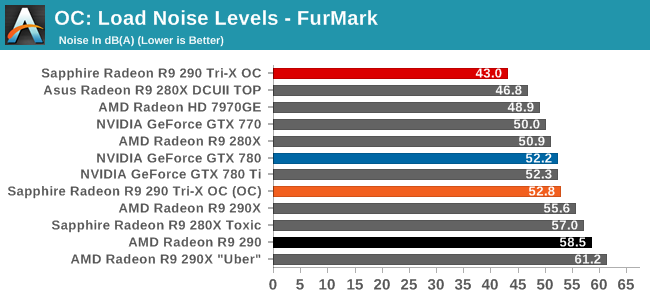
Even with our overclocking the 290 Tri-X OC still holds up rather well when it comes to Crysis 3. At 45.6dB this is a 4.5dB increase in noise, more than enough to be noticed, but notably it’s still quieter than our stock 280X and 7970GE, both of which are similarly open air coolers. FurMark on the other hand pushes the card much harder since it’s reaching the new 120% PowerTime power limit, leading to a jump in noise of just under 10dB to 52.8dB. Even faced with an overclocked FurMark the Tri-X cooler is still holding up very well, though we’ve clearly reached the point (with regards to thermal loads) where it has lost its near-silence.










119 Comments
View All Comments
Drumsticks - Wednesday, December 25, 2013 - link
More or less exactly! Anandtech can do what they want but I do kind of hate our silly system of measurement. It isn't going anywhere sadlymond0 - Wednesday, December 25, 2013 - link
From his tone, it's clear that he's not being defensive, but merely pointing out the reasons why AnandTech uses imperial measurements to a person who felt like it was Ryan's *duty* to spoon feed him metric measurements so he wouldn't have to do "calculations in the head" while the majority of the viewerbase would. Calling him "defensive" is the closest thing to "you mad bro" you can say.juhatus - Wednesday, December 25, 2013 - link
Sorry, I was not trying to be smart ass about this. I bet the split for readers is 50% US and 50% international. I really tried to be as neutral as I can and no I don't help calculating.Ryan any comment? Is there any policy about standards?
bigboxes - Thursday, December 26, 2013 - link
Sorry. It's not 50/50. I'm sure that it's >70%, but you've got me curious as to the real numbers. Almost everything on this site is for American buyers. You get the occasional "it's only available in Europe", but usually it's US-centric. So inches it is. You can get an android conversion app if you don't want to google it.bigboxes - Thursday, December 26, 2013 - link
HA! I was wrong. US only 33.6% of traffic. D'oh!ShieTar - Wednesday, December 25, 2013 - link
"the majority of the buyers of this level of video card are also in the U.S."I'm confused, how would you figure that? The European markets for consumer electronics have overtaken the North-American market in volume about a decade ago, and 2-3 years ago the combined volume of both have become smaller than the Asian market. Even with a relatively high-end card like this, I would be surprised if more than 25% of sales go to the U.S. these days.
Also, why would a majority of AT readers be American? Funny measurement units and the price comparisons aside, there is nothing on here that is specifically tailored to the US market. As the majority of tech-savy Europeans is rather fluid in English, I'm sure AT gets just as many European readers, keeping in mind the much larger overall population.
TheJian - Saturday, December 28, 2013 - link
I didn't realize Europe was a country...Silly me. This is a USA site, get over it. The site is based in NC, USA last I checked and am unaware of it having any server in another country. You're more than welcome to FUND the development of a FOREIGN soil based expansion.Does any single country buy more than your assumed 25% that goes to USA? Germany, Russia, France etc? You're counting europe as one entity and it's not. There is nothing wrong with catering to his OWN audience. If you want to read it from outside, fine. But don't expect anyone to alter their world to suit yours. It's just not this site's job. There are not many other web sites with multi language and I don't know of many USA sites using multi-language or even metric.
With US traffic being 33%, there is no other larger country coming to read this site correct? I translate chinese/german tech pages all the time. Sure I wish they'd put them up in English for me, but realize that it is cost prohibitive to do so. No point in asking as I'd rather have that cost go to reviewing more products etc. That's what translators are for anyway :)
ShieTar - Monday, December 30, 2013 - link
You seem to be a little confused about my statement. Try reading it again, and point out to me where I demanded that AT change anything? I merely pointed out some weak points in the comment of "wetwareinterface". I also did not pretend Europe was a country, merely an economic entity, which it is. I live in Europe, working for a European company, I can order products from any European shop without having to bother about any customs/tariff, I can move to and work in any other European Union country without any paperwork, etc. The different national governments at this point are merely another level of administration, but not something that seriously affects our everyday life.More importantly though, none of that matters to my original point, which was just to point out that an estimated 25% are a far way from "the majority", as the other 75% who come from "metric system nations" would be clearly the majority.
mpdugas - Thursday, December 26, 2013 - link
Since number systems are purely imaginary, what difference does how you measure an object make?Some folks find fractions easy, some like decimals better, but they are just fractions, too.
It really just comes down to which you prefer; the object does not change, no matter which fraction system you use.
xTRICKYxx - Tuesday, December 24, 2013 - link
Wow, that cooler is something else.